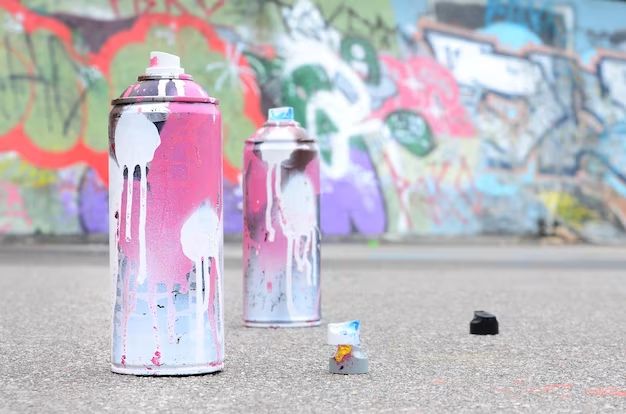When looking to use spray paint for outdoor projects, it’s important to choose a type of paint that is specifically formulated to withstand outdoor elements. The key factors to consider when selecting exterior spray paint include durability, UV resistance, adhesion, and color retention. Using the right outdoor spray paint will ensure your project looks great and lasts a long time.
Page Contents
Factors to Consider When Choosing Exterior Spray Paint
Here are the main factors to keep in mind when selecting an outdoor spray paint:
Durability
Outdoor spray paint needs to stand up to weather elements like sun, rain, snow, and temperature changes. Look for paints that are rated for exterior use and formulated with resins and pigments that won’t fade, chalk, crack, or peel when exposed to the elements.
UV Resistance
The sun’s ultraviolet (UV) rays can cause paints to fade over time. Make sure to choose an exterior paint with UV inhibitors that limit fading and protect the binders in the paint. UV-resistant spray paint will retain its color much longer.
Adhesion
Proper adhesion is crucial for exterior paints. The paint needs to bond tightly to surfaces like wood, plastic, metal, concrete, and more. Check that the spray paint is designed to stick to your particular surface material.
Color Retention
You want the color you choose to last. Opt for spray paints marketed as fade-resistant or guaranteed to keep their color for years. Darker colors may be more prone to fading than lighter colors.
Types of Exterior Spray Paint
There are several major categories of outdoor spray paint to consider:
Acrylic Lacquer
Acrylic lacquer spray paints provide excellent adhesion and UV resistance. They dry to a hard, durable finish that resists cracking, chipping, and fading. Acrylic lacquers work well on metal, plastic, wood, and more.
Enamel
Enamel paints contain varnishes that make them extra durable for outdoor use. They provide a glossy, protective finish that holds up to weather very well. Enamel spray paint adheres best to metal and wood.
UV-Resistant
As the name suggests, these spray paints contain UV blockers that prevent fading and sun damage. They provide long-lasting color for outdoor projects and work on most surfaces including plastic, wicker, metal, and wood.
High Heat
For painting surfaces that get very hot like grills, engines, or pipes, look for exterior spray paints designed for high heat applications up to 500°F. The binders and pigments are formulated to withstand extreme temperatures.
Specialty
Specialty spray paints are designed to work on specific materials like wicker, masonry, galvanized metal, fabric, or grass and turf. Check the spray paint’s label to ensure compatibility with your surface material.
Best Surfaces for Exterior Spray Paint
While exterior spray paint can usually work on multiple surface types, some provide better results than others:
Metal
Spray paint adheres very well to most bare metals including iron, steel, aluminum, copper, and tin. Metals provide a smooth, consistent base.
Wood
Unfinished, untreated, or previously painted wood also makes a great canvas for spray paint. The porous surface allows for strong adhesion.
Plastics
Smooth, hard plastics like PVC, ABS, acrylic, and fiberglass work well with exterior spray paint. Make sure to scuff glossy plastic first.
Wicker
Spray paint formulated for wicker provides long-lasting color for outdoor wicker furniture. Make sure to use thin coats to prevent pooling in the woven material.
Concrete
Concrete’s porous, grippy surface provides excellent adhesion for exterior paints. Etching or priming first provides even better results.
Best Practices for Applying Exterior Spray Paint
Follow these tips to get great results from outdoor spray paint:
- Wash the surface with soap and water first to remove any dirt, grease, or mildew.
- Sand glossy surfaces to roughen them up for better adhesion.
- Mask off any areas you don’t want painted.
- Apply primer if needed based on the surface material.
- Use light, even coats from the proper spraying distance.
- Let each coat dry completely before adding another.
- Follow the manufacturer’s recommended number of coats for full coverage and protection.
- Apply a clear sealer or topcoat for added durability.
How to Choose Exterior Spray Paint Colors
Choosing the right color is important for any paint project. Here are some tips when selecting spray paint colors for outdoor use:
- Opt for light, bright colors which help surfaces stand out in the sun.
- Neutrals like grays, browns, and beiges work well for a natural look.
- Whites and off-whites keep their color better than bright whites.
- Darker colors show wear and fading more over time.
- Complement your home’s color scheme for a cohesive look.
- Use an accent color on outdoor furniture or decorative pieces.
- Pick a color that fits the style of your home’s architecture.
Conclusion
Choosing the right exterior spray paint involves considering durability, UV resistance, adhesion, and color retention. Acrylic lacquers, enamels, and specialty paints formulated for outdoor use provide the best results. Metal, wood, plastic, wicker, and concrete make ideal surfaces when properly prepped. Following best practices for surface prep, spray technique, and recoat times leads to long-lasting spray paint jobs outside. And opting for light, bright, neutral, or complementary colors ensures your painted surfaces will look great for years to come.
